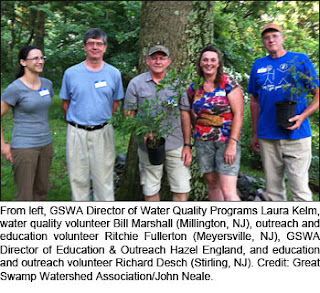Great Swamp Watershed Association presents awards for outstanding service in 2012-13.
The Great Swamp Watershed Association (GSWA) honored three area residents for their outstanding service as volunteers over the past year. The announcements were made during the environmental organization’s annual Volunteer Appreciation Picnic on Tuesday, June 25.Millington resident Bill Marshall was recognized for his contributions to GSWA’s water quality programs. For the past two years, he has worked with the organization’s Stream Team to assist with the collection of scientific data from the five major streams of New Jersey’s Great Swamp.
Marshall has been instrumental in conducting scientific visual assessments of waterways, collecting water samples for chemical analysis, and, more recently, helping GSWA launch a monitoring program for waterborne bacteria.
Meyersville resident Ritchie Fullerton and Stirling resident Richard Desch were both recognized for their contributions to GSWA’s outreach and education programming. Both honorees began their involvement in the organization through events sponsored jointly with Northern New Jersey Cachers (NNJC.org), a group dedicated to promoting the outdoor sport of geocaching statewide.
Fullerton and Desch provided critical support over the past year for two major efforts aimed at increasing awareness of the natural world in and around New Jersey’s Great Swamp. GSWA’s Halloween-themed Spooky Swamp Walk—held on the 26 and 27 of October, 2012—introduced participants to the organization’s 53-acre, Conservation Management Area—a publicly accessible natural area and demonstration site for environmental restoration projects. GSWA’s Great Swamp Scavenger Hunt, held on May 11, 2013, introduced a host of geocachers and many others to the sights and sounds of the larger 55-square-mile Great Swamp Watershed region by sending them out to explore outdoor destinations like the U.S. Fish and Wildlife Service’s Great Swamp National Wildlife Refuge and Morris County’s Great Swamp Outdoor Education Center in Chatham Township, NJ.
In appreciation of their contributions, GSWA presented all three honorees with appropriate swamp-related gifts. Marshall received a copy of the National Audubon Society Field Guide to the Mid-Atlantic States which includes information about plants and wildlife commonly found in the Great Swamp. Fullerton and Desch each received a northern highbush blueberry shrub to plant at home. The highbush blueberry (Vaccinium corymbosum) is native to the eastern U.S. and commonly found in the Great Swamp region.
The Great Swamp Watershed Association sincerely thanks all of its 2012-13 volunteers for the excellent work they have done to protect the waters and the land of the Great Swamp Watershed we all love and share. If you are interested in joining one GSWA’s environmental volunteer programs, please visit the organization online at GreatSwamp.org, or call 973-538-3500 for more information.





